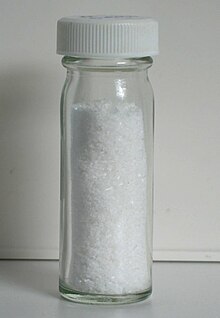Caesium perchlorate

| |

| |
| Names | |
|---|---|
| IUPAC name
Caesium perchlorate
| |
| Other names
Cesium perchlorate
| |
| Identifiers | |
| |
3D model (JSmol)
|
|
| ChemSpider | |
| ECHA InfoCard | 100.033.298 |
| EC Number |
|
PubChem CID
|
|
CompTox Dashboard (EPA)
|
|
| |
| |
| Properties | |
| CsClO4 | |
| Molar mass | 232.36 g/mol |
| Appearance | Colorless crystals |
| Density | 3.327 g/cm3 |
| Melting point | 250 °C (482 °F; 523 K) (decomposes) |
| 1.974 g/100 ml (25 °C) | |
Solubility product (Ksp)
|
3.95×10−3[3] |
Refractive index (nD)
|
1.4887 |
| Structure | |
| orthorhombic (<219 °C) cubic (>219 °C, a = 798 pm) | |
| Pnma (<219 °C) F43m (>219 °C) | |
a = 982 pm, b = 600 pm, c = 779 pm (orthorhombic, <219 °C)
| |
| Hazards | |
| Safety data sheet (SDS) | External MSDS |
| Flash point | Non-flammable |
| Related compounds | |
Other anions
|
Caesium chloride |
Other cations
|
Lithium perchlorate Sodium perchlorate Potassium perchlorate Rubidium perchlorate |
Except where otherwise noted, data are given for materials in their standard state (at 25 °C [77 °F], 100 kPa). | |
| Infobox references | |
Caesium perchlorate or cesium perchlorate (CsClO4), is a perchlorate of caesium. It forms white crystals, which are sparingly soluble in cold water and ethanol. It dissolves more easily in hot water.
CsClO4 is the least soluble of the alkali metal perchlorates (followed by Rb, K, Li, and Na), a property which may be used for separatory purposes and even for gravimetric analysis. [4] This low solubility played an important role in the characterization of francium as an alkali metal, as francium perchlorate coprecipitates with caesium perchlorate.[5]
| Temperature (°C) | 0 | 8.5 | 14 | 25 | 40 | 50 | 60 | 70 | 99 |
|---|---|---|---|---|---|---|---|---|---|
| Solubility (g / 100 ml) | 0.8 | 0.91 | 1.91 | 1.974 | 3.694 | 5.47 | 7.30 | 9.79 | 28.57 |
When heated, CsClO4 decomposes to caesium chloride above 250 °C. Like all perchlorates, it is a strong oxidant and may react violently with reducing agents and organic materials, especially at elevated temperatures.
References[]
- ^ a b Perry, Dale L.; Phillips, Sidney L. (1995), Handbook of Inorganic Compounds, CRC Press.
- ^ a b Brezina, F.; Mollin, J.; Pastorek, R.; Sindelar, Z. (1986), Chemicke tabulky anorganickych sloucenin, SNTL.
- ^ John Rumble (June 18, 2018). CRC Handbook of Chemistry and Physics (99 ed.). CRC Press. pp. 5–188. ISBN 978-1138561632.
- ^ Greenwood, Norman N.; Earnshaw, Alan (1984). Chemistry of the Elements. Oxford: Pergamon Press. p. 1017. ISBN 978-0-08-022057-4..
- ^ Hyde, E. K. (1952), "Radiochemical Methods for the Isolation of Element 87 (Francium)", J. Am. Chem. Soc., 74 (16): 4181–84, doi:10.1021/ja01136a066, hdl:2027/mdp.39015086483156
External links[]
| HClO4 | He | ||||||||||||||||
| LiClO4 | B(ClO 4)− 4 |
NH4ClO4 |
H3OClO4 | FClO4 | Ne | ||||||||||||
| NaClO4 | Mg(ClO4)2 | Al(ClO 4)− 4 Al(ClO 4)3− 6 |
Si | P | S | ClO− 4 ClOClO3 Cl2O7 |
Ar | ||||||||||
| KClO4 | Ca(ClO4)2 | Sc(ClO4)3 | Ti(ClO4)4 | VO(ClO4)3 VO2(ClO4) |
Cr(ClO4)3 | Fe(ClO4)2 | , |
Cu(ClO4)2 | Ge | As | Se | Br | Kr | ||||
| RbClO4 | Sr(ClO4)2 | Zr(ClO4)4 | Mo | Tc | Ru | Rh(ClO4)3 | AgClO4 | Sb | I | Xe | |||||||
| CsClO4 | Ba(ClO4)2 | W | Re | Os | Ir | Pt | Au | , |
, |
Po | At | Rn | |||||
| Ra | Rf | Db | Sg | Bh | Hs | Mt | Ds | Rg | Cn | Nh | Fl | Mc | Lv | Ts | Og | ||
| ↓ | |||||||||||||||||
| La | Pr | Nd | Pm | ||||||||||||||
| Ac | Pa | Np | Pu | Am | Cm | Bk | Cf | Es | Fm | Md | No | Lr | |||||
- Caesium compounds
- Perchlorates